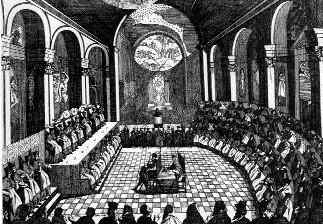First Council of Lyon
The First Council of Lyon (Lyon I) was the thirteenth ecumenical council, as numbered by the Catholic Church, taking place in 1245.
| First Council of Lyon | |
|---|---|
| Date | 1245 |
| Accepted by | Catholic Church |
Previous council | Fourth Council of the Lateran |
Next council | Second Council of Lyon |
| Convoked by | Pope Innocent IV |
| President | Pope Innocent IV |
| Attendance | 250 |
| Topics | Emperor Frederick II, clerical discipline, Crusades, Great Schism |
Documents and statements | thirty-eight constitutions, deposition of Frederick, Seventh Crusade, red hat for cardinals, levy for the Holy Land |
| Chronological list of ecumenical councils | |
| Part of a series on |
| Ecumenical councils of the Catholic Church |
|---|
 Renaissance depiction of the Council of Trent |
| Antiquity (c. 50 – 451) |
| Early Middle Ages (553–870) |
| High and Late Middle Ages (1122–1517) |
| Modernity (1545–1965) |
|
|

The First General Council of Lyon was presided over by Pope Innocent IV. Innocent IV, threatened by Holy Roman Emperor Frederick II, arrived at Lyon on 2 December 1244, and early the following year he summoned the Church's bishops to the council later that same year. Some two hundred and fifty prelates responded including the Latin Patriarchs of Constantinople, Antioch, and Aquileia (Venice) and 140 bishops. The Latin emperor Baldwin II of Constantinople, Raymond VII, Count of Toulouse, and Raymond Bérenger IV, Count of Provence were among those who participated. With Rome under siege by Emperor Frederick II, the pope used the council to excommunicate and depose the emperor with Ad Apostolicae Dignitatis Apicem,[1] as well as the Portuguese King Sancho II.[2] The council also directed a new crusade (the Seventh Crusade), under the command of Louis IX of France, to reconquer the Holy Land.[3]
At the opening, on 28 June, after the singing of the Veni Creator, Spiritu, Innocent IV preached on the subject of the five wounds of the Church and compared them to his own five sorrows: (1) the poor behaviour of both clergy and laity; (2) the insolence of the Saracens who occupied the Holy Land; (3) the Great East-West Schism; (4) the cruelties of the Tatars in Hungary; and (5) the persecution of the Church by the Emperor Frederick.
At the second session on 5 July, the bishop of Calvi and a Spanish archbishop attacked the emperor's behaviour, and in a subsequent session on 17 July, Innocent pronounced the deposition of Frederick. The deposition was signed by one hundred and fifty bishops and the Dominicans and Franciscans were given the responsibility for its publication. However, Innocent IV did not possess the material means to enforce the decree.
The Council of Lyon promulgated several other purely disciplinary measures:
- It obliged the Cistercians to pay tithes,
- It approved the Rule of the Grandmontines,
- It decided the institution of the Octave of the Nativity of the Blessed Virgin,
- It prescribed that cardinals were to wear a red hat,
- It prepared thirty-eight constitutions which were later inserted by Boniface VIII in his Decretals, the most important of which decreed a levy of a twentieth on every benefice for three years for the relief of the Holy Land.
Among those attending was the future saint Thomas Cantilupe who was made a papal chaplain and given a dispensation to hold his benefices in plurality.[4]
Notes
- Christopher M. Bellitto, The General Councils:A History of the Twenty-One Church Councils from Nicaea to Vatican II, (Paulist Press, 2002), 57.
- H. Salvador Martínez, Alfonso X, the Learned, Trans. Odile Cisneros, (Brill, 2010), 380.
- Larry H. Addington, The Patterns of War Through the Eighteenth Century, (Indiana University Press, 1994), 59-60.
- Oxford Dictionary of National Biography